Posts Tagged ‘Iwo Jima’


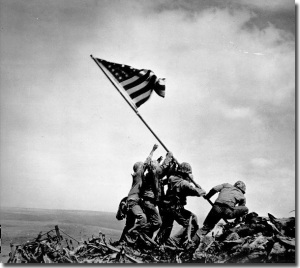
Flag-raising on Mount Suribachi, Iwo Jima on February 23, 1945. Courtesy of The National Archives and Records Administration.
The National WWII Museum’s Annual Student Essay contest will officially begin on January 5, 2015! This year’s middle and high school essay contest prompt, “How do you define a hero?” was inspired by the upcoming 70th anniversary of the iconic flag raising on Mount Suribachi at Iwo Jima. The six men who helped to raise the flag in the midst of battle on February 23, 1945, are often referred to as heroes. Three of them, John Bradley, Ira Hayes (Pima) and Rene Gagnon, survived the war while the remaining three, Sgt. Michael Strank, Pfc. Frank Sousley, and Corporal Harlon Henry Block, were either killed on Iwo Jima or died before the war had ended. One of the survivors, Ira Hayes, was repeatedly asked by admirers if he considered himself to be a hero as a result of his wartime actions. Hayes replied:
“How could I feel like a hero when only five men in my platoon of 45 survived, when only 27 men in my company of 250 managed to escape death or injury?”
For this year’s essay contest, participating students are asked to think and write about what being a hero means to them. While not a research paper per se, students must use WWII as a starting point for their responses and provide specific examples from their own experiences that support their ideas and connect with the prompt, “How do you define a hero?” Essays will be evaluated based on the student’s use of historic and contemporary evidence to support their argument, historical accuracy, and the essay’s originality, as well as clarity of expression, adherence to the contest theme, grammar, and punctuation.
The 2015 Museum Student Essay Contest is open to all middle school students (Grades 5-8) and all high school students (Grades 9-12) in the United States, United States territories, and military bases, and closes on March 31, 2015. Middle school students in grades 5-8 must write and submit an essay that is 500 words or less and entries will be eligible to win up to $250 and other prizes. Participating high school students in grades 9-12 are required to submit an essay that is 1,000 words or less, with a chance to receive up to $1,000 for a first place essay. Both winning essays and honorable mentions will be posted on The National WWII Museum website.
All essays must be submitted through The National WWII Museum’s Essay Contest website by March 31, 2015, 5:00 p.m. CST. Only essays received before the deadline and in Microsoft Word or Pdf. format will be considered for awards. For more information about the 2015 Essay Contest, please visit the Museum’s contest site at www.nationalww2museum.org/essaycontests. We look forward to reading all of this year’s fabulous essays!
To learn more about what the fighting conditions were like at Iwo Jima and why the flag-raising was such an important symbol during the battle, explore the oral histories of two Marines who fought on the island, David Severance and Medal of Honor recipient Herschel “Woody” Williams. Check out the Museum’s Iwo Jima fact sheet and Focus On feature, as well as historic photographs and other interviews on The Digital Collections of The National WWII Museum website, too.
Post by Megan Byrnes, K-12 Curriculum Coordinator.
Stay in touch! Sign up for our free monthly teacher e-newsletter, Calling All Teachers, and keep up with our other educational opportunities and latest resources!
-
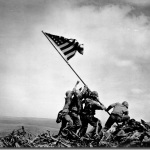
- Flag-raising on Mount Suribachi, Iwo Jima on February 23, 1945. Courtesy of The National Archives and Records Administration.
-
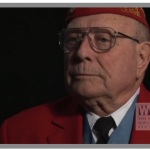
- Medal of Honor recipient Herschel "Woody" Williams fought on Iwo Jima as a Demolition Sergeant with the 1st Battalion, 21st Marines, 3rd Division.
-
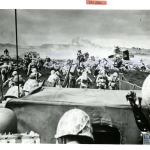
- D-Day on Iwo Jima with the 4th Infantry. February 19, 1945. U.S. Navy, Gift of Charles Ives, from the collection of The National WWII Museum. 2011.102.559.
-
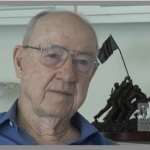
- David Severance fought on Iwo Jima with the 28th Marines, which raised both flags during the battle on February 23, 1945.
-
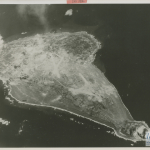
- Aerial reconnaissance photograph of Iwo Jima prior to invasion, February 1945. U.S. Navy, Gift of Charles Ives, from the collection of The National WWII Museum. 2011.102.536.
-
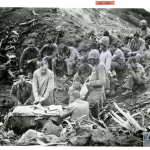
- Mass is held on Mount Siribachi with the 5th Division Marines attending services, February 1945. U.S. Navy, Gift of Charles Ives, from the collection of The National WWII Museum. 2011.102.562.
-
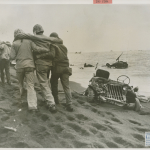
- Wounded Marines on Iwo Jima are being taken to an aid station. U.S. Navy, Gift of Charles Ives, from the collection of The National WWII Museum. 2011.102.538.
-
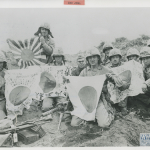
- Iwo Jima battle flags captured by 5th Division Marines. U.S. Navy, Gift of Charles Ives, from the collection of The National WWII Museum. 2011.102.526.
-
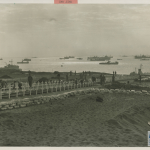
- Uncompleted cemetery on Iwo Jima for the 3rd and 4th Divisions of Marines. U.S. Navy, Gift of Charles Ives, from the collection of The National WWII Museum. 011.102.539.
-
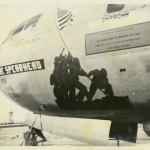
- Joe Rosenthal's photograph of the flag-raising on Iwo Jima became famous quickly, as shown by the nose art on this B-29 Superfortress on the island of Tinian in 1945. Gift of David Lawrence, from the collection of The National WWII Museum. 2012.195.156.



On October 14, 1944 the USS Houston became the first major ship attacked by Japanese pilots off the coast of Formosa, what is now called Taiwan. The USS Houston left for combat in April 1944 joining Task Force 58, the main striking force in the US Navy in the Pacific Theater. The boat and its crew participated in shore bombardments and covered landings of the island hopping campaign across the Pacific including the Marianas, Roto, Guam, Iwo Jima, Chichi Jima, Philippines, Anguar, Luzon, Mindanao, Leyte, and Samar.
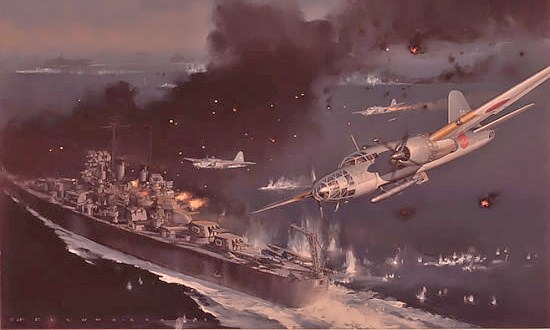
Ordeal of the USS Houston from Jack Fellows’ book on the ship.
It was just after sunset on October 14, 1944 that the USS Houston’s was struck by a Japanese torpedo after successfully shooting down three of the four attacking planes. The ship was immediately dead in the water without power. During this time, the typical protocol was for the crew to abandon ship and let the vessel sink. The USS Houston was leaning over in the water, and the men were ordered to evacuate the ship.
The vast majority of the crew of 992 survived, but 4 officers and 51 enlisted perished. The Japanese reported that the USS Houston had sunk resulting in newspaper headlines describing that success on the Japanese Home Front. But in fact, the crew of the ship refused to let the USS Houston sink, and over 700 hundred of the crewmen and 33 of the officers were transferred to accompanying US ships and the ship was stabilized to tow. The boat was towed to Ulithi by USS Boston and USS Pawnee and eventually made its way to Brooklyn, New York for repairs that were completed just after the war’s end in 1945. The ship received 3 battle stars for its service during World War II.
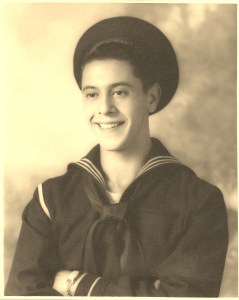
Joseph Ignatius “J.I” Monte during WWII.
To commemorate the 70th Anniversary of this event and to fulfill the last wishes of one of the USS Houston’s crew members, daughter Lori Besselman and son Frank Monte of Jim “J.I.” Monte will be taking a voyage to the coast of Taiwan to put the ashes of their father at rest where he lost his crew.
Born in 1925 J.I., a New Orleans native, joined the US Navy in September 1942 at the age of 17 after much fight with his father to sign for his underage enlistment. After becoming temporarily blind while working as a Welder-Burner at the Delta Shipbuilding Corporation in New Orleans, his family decided they might as well send him to war before he got killed in the shipyard. He served in New Orleans until he was 18 when he signed on for duty. He traveled to Norfolk, Virginia for training and joined as a plank member, the first crew, of the crew of the USS Houston in December 1943.
During the torpedoing by the Japanese on October 14, 1944, J.I. sprained his ankle due to the deck heaving up on the high side of the ship. Because of his injury, J.I. was thrown overboard by his shipmates where he was able to swim to a life raft. He spent the night in the raft with others from the ship before they were picked the following destroyer USS Grayson.
On October 17 J.I. transferred to the cruiser USS Birmingham, and the following day, October 18, he transferred to the escort carrier, USS Rudyerd Bay. The Rudyerd Bay transported him to Ulithi Atoll. There he boarded the USS Typhoon and traveled to Pearl Harbor. Upon arrival in Pearl Harbor, the Typhoon received a welcome by Admiral Nimitz and the Navy Band playing “Anchors Aweigh.” Jim described the scene as well as quite comical because the USS Houston survivors received the welcome while wearing nothing but their undergarments, boxers and undershirts. When the crewmembers were evacuated they were only given those items to wear.
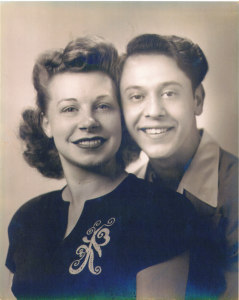
Verna and J.I. or “Jim” as she called him. When they met in California, J.I. had his initials JIM for Joseph Ignatius Monte sewn on his clothes. Verna thought it was for his name being “Jim” and continued to call him that throughout their life together.
After returning from the Pacific Theater in December 1944, J.I. was stationed at the Alameda Naval Air Station outside of Oakland, California for the remainder of the war. It was here where he met his wife Verna, who was from Iowa, while riding the trolley. Verna was also working at the Naval Air Station painting instrument dials on planes. In July 1945 the couple married, and they ventured back to J.I.’s hometown of New Orleans upon his discharge in October 1945. Together they had 5 children.
From his time in the Navy to working for the US Treasury and the US Customs Department, J.I. accumulated over 40 years of services to the government. When he retired at the age of 65, he stayed active by volunteering and serving as the Gate Chairmen for the Destrehan Plantation Festival. Alongside his wife Verna, he delivered hot meals to people living with AIDS through the New Orleans AIDS Task Force multiple times a week.
Like many WWII veterans, he didn’t talk much about his experience in war until later in life. His wife Verna described that “as he got older, the time he spent in the service became more important to him.” From that time, he became more involved with the Houston Association and hosted a reunion for the ship in New Orleans at the Westin Hotel in 1997 with at least 150 survivors and their families in attendance. He even began proudly wearing a WWII Veterans Cap that was purchased from the Museum’s gift shop. It honored him greatly to receive words of gratitude from people both young and old for his service to our country. In 2010, he received another great honor from Governor Bobby Jindal when he was awarded the Louisiana Veterans Medal of Honor for his service during WWII. Jim “J.I.” Monte passed away on January 18, 2012.
The children of Jim, Lori and Frank, are excited to have made this venture to Asia to fulfill their father’s wishes. They grew up with him saying, “I want my ashes to be in the South China Sea,” and now they have made that wish come true.
-
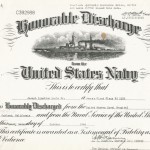
- The discharge papers of J.I.
-
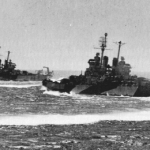
- USS Houston during a shore bombardment of Guam (closer to the camera) in a high speed turn with sister-ship Vincennes.
-
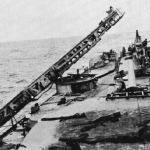
- View looking aft showing the damage to the starboard catapult after the first torpedo hit.
US Navy Official photograph.
-
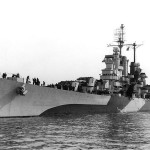
- USS Houston (CL 81) Off the Norfolk Navy Yard, Virginia, 11 January 1944.
-
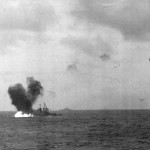
- Japanese aerial torpedo hits the ship's starboard quarter, during the afternoon of 16 October 1944. This view shows burning fuel at the base of the torpedo explosion's water column. Houston had been torpedoed amidships on 14 October, while off Formosa, and was under tow by USS Pawnee (ATF 74) when enemy torpedo planes hit her again. USS Canberra (CA 70), also torpedoed off Formosa, is under tow in the distance.
Official U.S. Navy Photograph, from the collections of the Naval Historical Center #NH 98826.
-
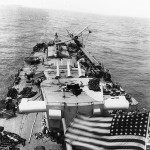
- View looking aft, showing damage to the ship's stern area resulting from a torpedo hit amidships received off Formosa on 14 October 1944. This photo was taken while Houston was under tow, but prior to the second torpedo hit on 16 October. Note OS2U floatplane that had been jarred off the port catapult, breaking its wing on impact with the aircraft crane.
Photograph from the Bureau of Ships Collection in the U.S. National Archives #19-N-106304.
-
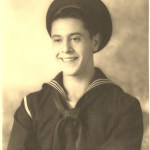
- J.I. during his service.
-
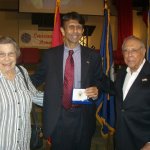
- J.I. receiving the Louisiana Veterans of Medal of Honor from Governor Jindal alongside his wife Verna on April 16, 2010.
-
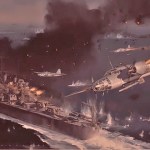
- Ordeal of the USS Houston from Jack Fellows' book on the ship.
-
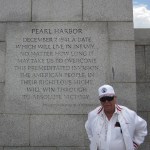
- J.I. at the World War II Memorial with the Louisiana Honor Air in May 2011.
-
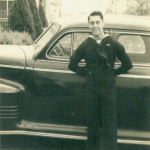
- J.I. during his service.
-
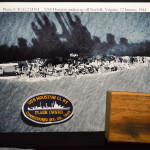
- As a plank member of the USS Houston, J.I. received a piece of the ship's plank when it was decommissioned and scrapped in 1959.
-
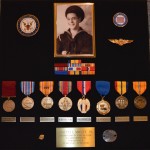
- The medals J.I. was awarded for his service in the US Navy.
-
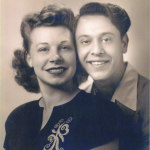
- Verna and J.I. or "Jim" as she called him. When they met in California, J.I. had his initials JIM for Joseph Ignatius Monte sewn on his clothes. Verna thought it was for his name Jim and continued to call him that throughout their life together.



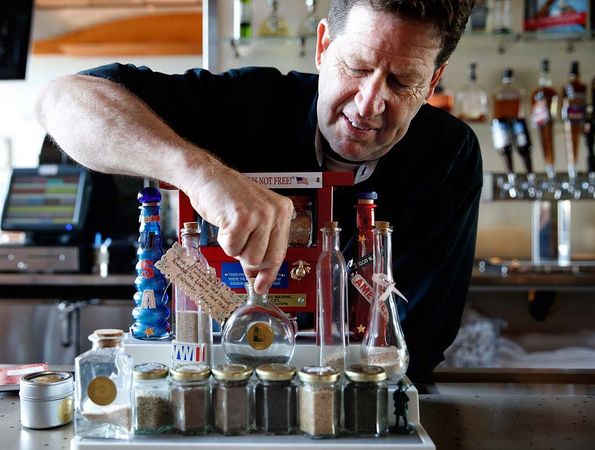
The July 12, 2013, Times-Picayune featured a story on an “exhibit” that many guests might miss on their visit to the Museum. Nestled among the bottles of liquor behind the bar at the Museum restaurant, the American Sector, are a collections of bottles and containers that have a very real and tangible link to history. Curated by bartender, Billy Vincent, the sand comes from Iwo Jima, Omaha Beach and the sites of 18 other D-Days. If was collected by visitors, Museum volunteers, staff, restaurant patrons and anyone who has heard about the collection and it is growing all the time. “There were 121 Pacific invasion sites,” Vincent said, ‘but I’m really looking for sand from the North Africa and Italy campaigns.”
Read the full article and see more photos of the collection.
Billy Vincent has been with the Museum since 2009. He is a proud veteran of the US Marine Corps.



Students at Viroqua Middle School in Wisconsin recently placed themselves in the middle of WWII geography—literally. Guided by student teacher Hannah Gutschenritter, they completed the Museum’s A Looong Way from Home lesson, where they researched and wrote about important WWII locations, used some online magic to determine the distances between those locations and their school, and built a distance signpost for their classroom; much like homesick soldiers did in faraway corners of the world during the war.

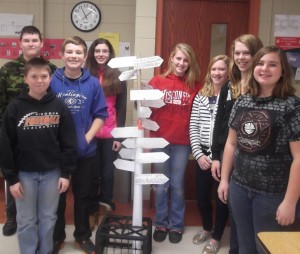
One of the best ways to engage students in history is to place them right in the center of that history. It’s one thing to learn about Iwo Jima, Normandy, Pearl Harbor, and Berlin. But when you can connect those faraway places with your hometown, you gain a much greater appreciation for the global nature of the war and its vast distances. From that understanding comes the more human appreciation for the emotions and experiences of young men and women who served overseas during WWII (and who still serve throughout the world today).
Check out the A Looong Way from Home lesson and many other lesson plans!
And rock on, Viroqua Middle School students!
Posted by Director of Education Kenneth Hoffman



With only a few more days to make a tax-deductible donation to The National WWII Museum in this calendar year, we wanted to take a moment to show you an example of what your contribution supports.
On display here at the Museum is a letter written in December of 1944 by Marine 1st. Lt. Leonard Isacks, Jr. to his two young sons, explaining why he’s far away from home at war and not with them for Christmas.
The letter, which you can read the full text of here, captures perfectly why more than 16 million Americans fought for freedom and why more than 400,000 willingly gave their lives in defense of liberty, including 1st Lt. Isacks who was killed on Iwo Jima two months after he wrote his sons.
It also represents the heart of the Museum’s mission — to tell the story of WWII from the perspective of men like 1st Lt. Isacks, an ordinary citizen-soldier who left his young family to defend America and our freedom.
We work each day to honor veterans like 1st Lt. Isacks and sustain the legacy of our nation’s WWII heroes to ensure all generations understand and appreciate the costly price of freedom.As we prepare for a new year here at the Museum, will you generously support our efforts with a contribution?
You can give securely online here.

Donated in loving memory by The Isacks Family, 2001.038




































